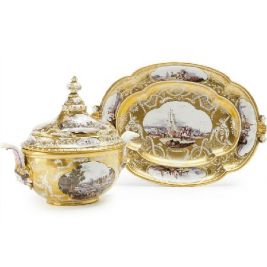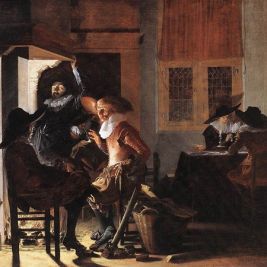
Sèvres porcelain
Sèvres Porcelain was established with the support of King Louis XV from its early days. This porcelain manufacture is one of the leading ones in Europe, mainly due to its original purpose of producing high-quality tableware and interior decorations. In subsequent years, the factory came under royal ownership, and currently, Sèvres Porcelain is produced under the management of the French Ministry of Culture. Over its 280-year history, Sèvres artisans have created numerous masterpieces from hard and soft porcelain.
 Sèvres porcelain. Dish from the service for Catherine II. Soft porcelain, 1778
Sèvres porcelain. Dish from the service for Catherine II. Soft porcelain, 1778
 Sèvres porcelain. Elephant vase with candlesticks, 1760
Sèvres porcelain. Elephant vase with candlesticks, 1760
History of the Sevres Factory in the 18th and 19th Centuries
The porcelain from the Sevres factory first appeared in the early 1750s, although the manufacture began its operations in 1740 in Vincennes. The initial production consisted of exquisite white biscuit sculptures. King Louis XV used these figures as diplomatic gifts, spreading the fame of decorative French porcelain. In 1756, production was moved to a new large building in Sèvres, initiated by Madame de Pompadour. From the 1770s, the factory's assortment expanded to include elegant items made of hard porcelain, which started to be produced after the discovery of French deposits of kaolin. Around the same period, the previously dominant Rococo style in sculpture gave way to Neoclassicism.
 Sèvres porcelain. Sculpture of Nymph with a Shell, after 1761
Sèvres porcelain. Sculpture of Nymph with a Shell, after 1761
 Sèvres porcelain. A plate from the Arabesque service in neoclassical style, 1785
Sèvres porcelain. A plate from the Arabesque service in neoclassical style, 1785
In the first half of the 19th century, Sèvres Porcelain was perfected under the guidance of Alexandre Brongniart, a chemist and professor of mineralogy. During his tenure, the primary focus of production shifted to hard porcelain, leading to the development of new mixtures and an updated color palette. Many complex and richly decorated pieces were created during this period, which were highly sought after in the royal courts of Europe. Brongniart also founded the Ceramic Museum, which has since become one of the largest in the world.
 Sèvres porcelain. Dish from the service for Paul I with the PP monogram
Sèvres porcelain. Dish from the service for Paul I with the PP monogram
In the second half of the 19th century, production underwent further modernization. New kilns were built, two of which are still in use today. They are lit on special occasions, such as jubilee celebrations. The artistic style of this period was characterized by eclecticism. The masters drew inspiration from Antiquity and the Renaissance, while also incorporating elements of Classicism and Rococo. Huge vases and services featuring scenes of Napoleon's military victories were created. The art of Japanese and Chinese porcelain was also studied.
 Sèvres porcelain. Renaissance cup, 1837
Sèvres porcelain. Renaissance cup, 1837
Sevres Manufacture in the 20th Century and Today
By the end of the 19th century, Sèvres porcelain no longer elicited the same enthusiasm at exhibitions. The new director, Alexandre Sandier, decided in 1900 to develop the Art Nouveau style. The factory abandoned outdated forms and bronze elements, softened the color palette, and produced smaller items. The Art Deco style, which developed in the 1920s, also found its reflection in Sèvres porcelain. The result was a triumph at the 1925 International Exhibition of Decorative Arts.
 Sèvres porcelain. Hector Guimard. Art Nouveau vase, 1903
Sèvres porcelain. Hector Guimard. Art Nouveau vase, 1903
During World War II, the factory worked for the needs of the occupiers and suffered heavily from bombings by the British Army, targeting the nearby Renault factory. Display cases with samples, windows, and an entire wing of the building were destroyed. 8,000 valuable items were damaged. Restoration work began in 1948. In the 1970s and 1980s, a new generation of artists and sculptors created unique porcelain pieces that corresponded to the trends of contemporary art.
 Sèvres porcelain. Leonard Agathon. Sculpture Dance with Scarf, 1908
Sèvres porcelain. Leonard Agathon. Sculpture Dance with Scarf, 1908
Creative experiments continue to this day, including collaborations with invited artists. Some samples of modern sculpture created at the Sèvres Manufacture are held in the world's finest museums. The factory regularly organizes thematic exhibitions and participates in festivals of contemporary art. In 2012, it was designated as part of France's "Living Heritage." Here are the names of several artists who collaborated with the manufacture at different times:
- Jean-Jacques Bachelier.
- Cornelis van Spaendonck.
- Jules-Clément Chaplain.
- Serge Poliakoff.
- Louise Bourgeois.
 Sèvres porcelain. Christine McKirdy. Sculpture Bone, 2012
Sèvres porcelain. Christine McKirdy. Sculpture Bone, 2012
The mission of the Sèvres Manufacture has remained unchanged since 1740. Its artisans continue to handcraft unique works of art, coming up with new creations and reproducing old masterpieces. If you are interested in high-quality porcelain, you can conveniently find it on the Very Important Lot website! Regular auctions are held here, where you can acquire antiques from different countries.

 German Porcelain: History of Creation and Development
German Porcelain: History of Creation and Development  The Return of Nature: Embracing Nature Renewal Art in 2024
The Return of Nature: Embracing Nature Renewal Art in 2024  The most famous representatives of French classicism in painting
The most famous representatives of French classicism in painting  The painting "Menshikov in Berezovo" by Vasily Surikov is a dramatic depiction of the life of the disgraced prince
The painting "Menshikov in Berezovo" by Vasily Surikov is a dramatic depiction of the life of the disgraced prince  Engraving is a captivating art of creating printed images
Engraving is a captivating art of creating printed images  Golden Age of Dutch painting - an era that gave the world the finest masterpieces of Dutch art of all times
Golden Age of Dutch painting - an era that gave the world the finest masterpieces of Dutch art of all times  Georges Braque - the founder of Cubism in world art
Georges Braque - the founder of Cubism in world art  Rococo: Peasant Idylls of Court Painters
Rococo: Peasant Idylls of Court Painters  The National Order of the Legion of Honour
The National Order of the Legion of Honour  Sandro Botticelli: Biography, Artistic Career, and the Best Paintings of the Artist
Sandro Botticelli: Biography, Artistic Career, and the Best Paintings of the Artist